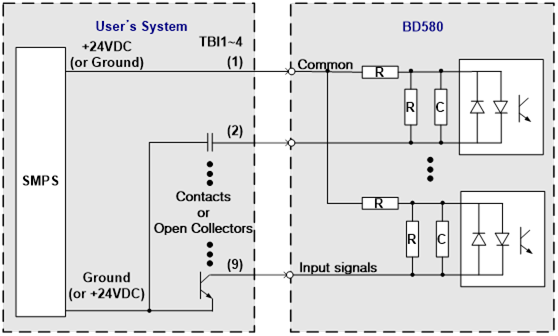5.1.2.1. Digital Input
5.1.2.1. Digital Input
The following Figure and Table describe the pin composition of the terminal block (TBI1~4) for digital input. Each terminal block connects to 8 input signals, and different power can be used depending on the usage.

Figure 5.2 Pin Configuration of Digital Input Terminal Block of Public IO Board (BD580)
Table 5‑1 Pin Configuration of Digital Input Terminal Block (TBln*) of Public IO Board (BD580)
Pin Number | Signal Name | Signal Description |
1 | COMn* | COMMON power (Ground DC24V or DC24V) |
2 | DI n*1 | 1st input of nth public input signal port of user |
3 | DI n*2 | 2nd input of nth public input signal port of user |
4 | DI n*3 | 3rd input of nth public input signal port of user |
5 | DI n*4 | 4th input of nth public input signal port of user |
6 | DI n*5 | 5th input of nth public input signal port of user |
7 | DI n*6 | 6th input of nth public input signal port of user |
8 | DI n*7 | 7th input of nth public input signal port of user |
9 | DI n*8 | 8th input of nth public input signal port of user |
10 | N.C | No connection |
Note *) Terminal block Number n = 1~4 (Ex, TBI1, TBI2, TBI3, TBI4)
The input specification of each port is as follows
l Input port component: AC input photocoupler
l Input impedance: 3㏀
l Common power: Ground 24VDC or 24VDC
The user connects the input signal through the method shown in Figure 5.3 below. First, connect the user power of +24V or the ground wire to the public IO board (BD580), and then connect each signal to the input pin according to the usage. For the power, 8 input ports can be composed as a unit, and can be used differently.

Figure 5.3 Wiring of Input Signals of the Public IO Board (BD580)
Caution: Public IO Board V3.0 or lower does not support two-way digital input. For this reason, DC24V must be used for common power. |